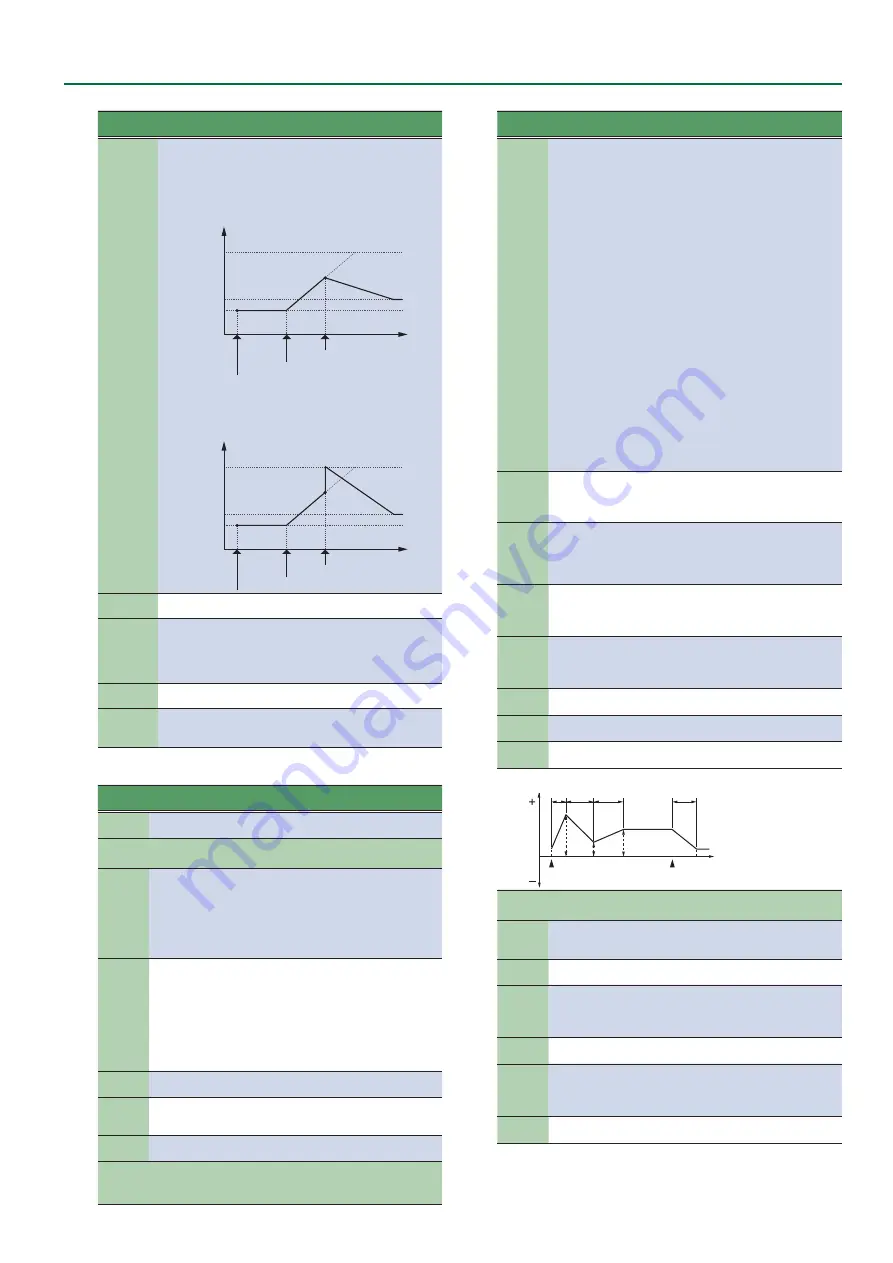
31
Sampling Menu
Item/Pa-
rameter
Value
Explanation
Portamento
Start *1
PITCH,
NOTE
PITCH:
If you press another key while the pitch is
changing, new portamento starts from the pitch
that was sounding at the moment you pressed the
key.
C5
D4
C4
Portamento Start: NOTE
Portamento Start: PITCH
C5
D4
C4
press D4 key
Pitch
Time
press C4 key
press C5 key
press D4 key
Pitch
Time
press C4 key
press C5 key
NOTE:
New portamento starts from the note at
which pitch change ended.
C5
D4
C4
Portamento Start: NOTE
Portamento Start: PITCH
C5
D4
C4
press D4 key
Pitch
Time
press C4 key
press C5 key
press D4 key
Pitch
Time
press C4 key
press C5 key
Cutoff
Offset *2
-63 - +63 Frequency at which the filter begins to take effect.
Resonance
Offset *2
-63 - +63
Amount by which the sound in the region of the
cutoff frequency is boosted, giving the sound a
distinctive character.
If this is raised excessively, oscillation might occur,
causing the sound to distort.
Attack Time
Offset *2
-63 - +63 Time from when the key is pressed until the attack
is completed
Release
Time Offset
*2
-63 - +63 Time from when the key is released until the sound
disappears
Tone Partial
Item / Pa-
rameter
Value
Explanation
Partial
Switch
OFF, ON
Partial on/off
WG
Modifies the pitch of the waveform or sound.
Wave
Group
INT,
SAMPLE,
MULTIS-
AMPLE
Group of the waveform (wave) that is assigned to the
partial
INT:
Internal tone waveforms
SAMPLE:
Sample waveforms
MSAM:
Multisample waveforms
* If you select Sample, the pitch will not change for keys that
are more than two octaves above the original key.
Wave No.L
(Mono)
Wave
No.R
OFF, 1 -
Selects the waveform. Together with the wave
number, the wave name is also shown at the bottom
of the screen.
If you’re using mono, specify only the left side (L). If
you’re using stereo, specify the right side (R) as well.
* If you’re using a multisample in stereo, specify the same
number for L and R.
* Likewise, when using a sample in stereo, specify the same
wave for L and R.
Wave
Gain
-6, 0, +6,
+12
[dB]
Gain (amplitude) of the waveform
Raising this 6 dB (decibels) doubles the gain.
Pitch
Coarse
Tune
-48–+48
Pitch of the partial (semitone units, ± 4 octaves)
Pitch Fine
Tune
-50–+50
Pitch of the partial (units of one cent = 1/100th of a
semitone)
TVF
The filter cuts a specific frequency region, modifying the brightness or
thickness of the sound.
Item / Pa-
rameter
Value
Explanation
TVF Filter
Type
OFF, LPF,
BPF, HPF,
PKG, LPF2,
LPF3
Type of filter
OFF:
Filter is not used
LPF:
Low Pass Filter. Cuts the frequency region above
the cutoff, making the sound more mellow.
BPF:
Band Pass Filter. Cuts the sound, leaving only
the region near the cutoff. This is useful for creating
sounds with a distinctive character.
HPF:
High Pass Filter. Cuts the frequency region
below the cutoff. This is useful for creating percussion
instrument sounds whose character lies in the high
frequency region.
PKG:
Peaking Filter. Boosts the region of the cutoff.
Using the LFO to cyclically modulate the cutoff fre-
quency produces a wah effect.
LPF2:
Low Pass Filter 2. This cuts the frequency region
above the cutoff, but the filter sensitivity is half that
of LPF. This is useful when simulating instrumental
sounds such as acoustic piano.
LPF3:
Low Pass Filter 3. This cuts the frequency region
above the cutoff, but the filter sensitivity changes
depending on the cutoff frequency. This is useful
when simulating acoustic instruments, but produces
a different nuance than LPF2 even with the same TVF
Envelope settings.
* If
“LPF2”
or
“LPF3”
are selected, the Resonance setting is
ignored.
TVF
Cutoff
Frequen-
cy
0–127
Frequency at which the filter starts to apply
TVF Reso-
nance
0–127
Amount by which the sound in the region of the cutoff
frequency is boosted, applying a distinctive character
to the sound
* Raising this excessively may produce oscillation, causing the
sound to distort.
TVF Env
Depth
-63–+63
TVF envelope depth
Increasing this value increases the change produced
by the TVF envelope. Negative
“-”
values invert the
shape of the envelope.
TVF Env
Attack
0–127
TVF envelope time
Increasing this value lengthens the time it takes to
reach the next cutoff frequency.
Adjusts ENV T1.
TVF Env
Decay
0–127
TVF envelope time
Adjusts ENV T3.
TVF Env
Sustain
0–127
TVF envelope level
Adjusts ENV L3.
TVF Env
Release
0–127
TVF envelope time
Adjusts ENV T4.
T1
T2
T3
T4
L3
L1
L0
L2
L4
Note off
Cutoff
Frequency
TVF Envelope
Time
Note on
TVA
These settings determine the volume.
TVA Tone
Level
0–127
Partial volume
This is used mainly to adjust the volume balance
between tones.
TVA Tone
Pan
L64–63R
Partial panning (left/right position)
TVA Env
Attack
0–127
TVA envelope time
Increasing this value lengthens the time it takes to
reach the next volume.
Adjusts ENV T1.
TVA Env
Decay
0–127
TVA envelope time
Adjusts ENV T3.
TVA Env
Sustain
0–127
TVA envelope level
Specifies how the volume at each point will change
relative to the LEVEL setting.
Adjusts ENV L3.
TVA Env
Release
0–127
TVA envelope time
Adjusts ENV T4.






























